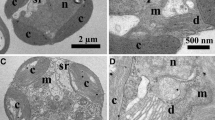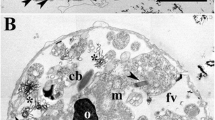Abstract
The first successful isolation of discharged ejectisomes from pigmented cryptophytes is reported. Discharged ejectisomes from a Chroomonas and two Cryptomonas species were characterized by transmission electron microscopy using negative staining and freeze-etching. Tubular-shaped fragments of variable lengths and diameters were obtained which showed a paracrystalline lattice. Particle periodicities of 4.1 nm along the longitudinal axis and 3.1 nm in the transverse direction were measured in negative-stained fragments. The dimensions measured from freeze-etched ejectisome fragments were about 0.5–1 nm larger. Sodium dodecyl sulfate polyacrylamide gel electrophoresis revealed a protein banding pattern, dominated by polypeptides of 40–44, 23–25 and 16–18 kDa. The results are discussed in the context of what is currently known about extrusomes of protists.





Similar content being viewed by others
References
Anderson E (1962) A cytological study of Chilomonas paramecium with particular reference to the so-called trichocysts. J Protozool 9:380–395
Bathke L, Rhiel E, Krumbein WE, Marquardt J (1999) Biochemical and immunochemical investigations on the light-harvesting system of the cryptophyte Rhodomonas sp.: evidence for a photosystem I specific antenna. Plant Biol 1:516–523
Dodge JD (1973) The fine structure of algal cells. Academic, London
Dragesco J (1951) Sur la structure des trichocystes du Flagelle cryptomonadine ChiIomonas paramecium. Bull Microsc Appl 1:172–175
Gautier M-C, Sperling L, Madeddu L (1996) Cloning and sequence analysis of genes coding for Paramecium secretory granule (Trichocyst) proteins. J Biol Chem 271:10247–10255
Grim JN, Staehelin LA (1984) The ejectisomes of the flagellate Chilomonas paramecium: visualization by freeze-fracture and isolation techniques. J Protozool 31:259–267
Hausmann K (1978) Extrusive organelles in protists. Int Rev Cytol 52:197–276
Hoppenrath M, Leander BS (2007) Morphology and phylogeny of the pseudocolonial dinoflagellates Polykrikos lebourae and Polykrikos herdmanae n. sp. Protist 158:209–227
Hovasse R, Mignot JP, Joyon L (1967) Nouvelles observations sur les trichocystes des cryptomonadines et les “R bodies” des particules kappa de Paramecium aurelia Killer. Protistologica 3:241–255
Janssen J, Rhiel E (2008) Evidence of monomeric photosystem I complexes and phosphorylation of chlorophyll a/c-binding polypeptides in Chroomonas sp., strain LT (Cryptophyceae). Int Microbiol 11:171–178
Kies L (1967) Oogamie bei Eremosphaera viridis De Bary. Flora, Abst B 157:1–12
Kugrens P, Lee RE, Corliss JO (1994) Ultrastructure, biogenesis, and functions of extrusive organelles in selected non-ciliate protists. Protoplasma 181:164–190
Laemmli UK (1970) Cleavage of structural proteins during assembly of head of bacteriophage T7. Nature 227:680–685
Lima O, Gulik-Krzywicki T, Sperling L (1989) Paramecium trichocysts isolated with their membranes are stable in the presence of millimolar Ca2+. J Cell Sci 93:557–564
Manton I (1969) Tubular trichocysts in a species of Pyramimonas (P. grossii PARKE). Österr Bot Z 116:378–392
Martin-Cereceda M, Roberts EC, Wootton EC, Bonaccorso E, Dyal P, Guinea A, Rogers D, Wright CJ, Novarino G (2010) Morphology, ultrastructure, and small subunit rDNA phylogeny of the marine heterotrophic flagellate Goniomonas aff. amphinema. J Eukaryot Microbiol 57:159–170
Morrall S, Greenwood AD (1980) A comparison of the periodic substructure of the trichocysts of the Cryptophyceae and Prasinophyceae. BioSystems 12:71–83
Rhiel E, Häder D-P, Wehrmeyer W (1988) Photo-orientation in a freshwater Cryptomonas species. J Photobiochem Photobiol BBiology 2:123–132
Rosati G, Modeo L (2003) Extrusomes in ciliates: diversification, distribution, and phylogenetic implications. J Eukaryot Microbiol 50:383–402
Santore UJ (1985) A cytological survey of the genus Cryptomonas (Cryptophyceae) with comments on its taxonomy. Arch Protistenk 130:1–52
Schuster FL (1968) The gullet and trichocysts of Cyathomonas truncata. Exp Cell Res 49:277–284
Schuster FL (1970) The trichocysts of Chilomonas paramecium. J Protozool 17:521–526
von Stein FR (1878) Der Organismus der Infusionsthiere.1.Abt.3. Der Organismus der Flagellaten. Berlin 1878, p.98, 111 and Pl.19
von Stosch HA (1973) Observations on vegetative reproduction and sexual life cycles of two freshwater dinoflagellates, Gymnodinium pseudopalustre Schiller and Woloszyskia apiculata sp. nov. Brit Phycol J 8:105–1034
Wehrmeyer W (1970) Struktur, Entwicklung und Abbau von Trichocysten in Cryptomonas und Hemiselmis (Cryptophyceae). Protoplasma 70:295–315
Acknowledgements
The authors express their gratitude to Ms. Silke Ammermann for the excellent technical assistance and Dr. Aron Stubbins (Old Dominion University, Norfolk, VA, USA) for the helpful comments and critical reading of the manuscript.
Conflict of interest
The authors declare that they have no conflict of interest.
Author information
Authors and Affiliations
Corresponding author
Additional information
In Memoriam of Prof. Dr. Werner Wehrmeyer, †2010-04-30
Handling Editor: Reimer Stick
Rights and permissions
About this article
Cite this article
Rhiel, E., Westermann, M. Isolation, purification and some ultrastructural details of discharged ejectisomes of cryptophytes. Protoplasma 249, 107–115 (2012). https://doi.org/10.1007/s00709-011-0267-4
Received:
Accepted:
Published:
Issue Date:
DOI: https://doi.org/10.1007/s00709-011-0267-4




